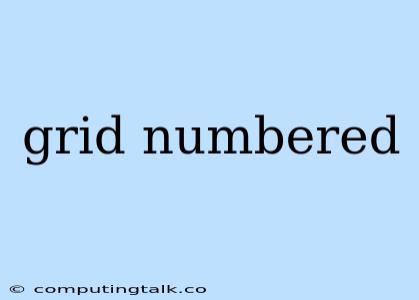A grid is a visual structure that helps organize information in a clear and accessible way. It is often used in web design, graphic design, and other fields to arrange elements in a consistent and visually appealing manner. Numbering a grid can be useful for several reasons, including:
- Improved navigation: Numbered grids can make it easier for users to find specific information.
- Enhanced readability: By numbering the rows and columns of a grid, you can create a visual hierarchy that improves readability.
- Easier data analysis: Numbered grids are often used in data analysis and reporting, as they can help users quickly identify patterns and trends.
Types of Numbered Grids
There are several types of numbered grids, each with its own unique characteristics:
- Row-numbered grid: In this type of grid, each row is assigned a number. This is a simple and effective way to number a grid, especially when dealing with a large amount of data.
- Column-numbered grid: In this type of grid, each column is assigned a number. This can be useful when you want to highlight specific columns or compare data across columns.
- Matrix-numbered grid: In this type of grid, both the rows and columns are assigned numbers. This is a more complex type of grid but can be useful for displaying complex data relationships.
How to Number a Grid
Numbering a grid is a straightforward process that can be done using various tools and methods.
- Spreadsheet software: Programs like Microsoft Excel or Google Sheets allow you to easily number grids by using the "Fill Handle" feature or entering formulas.
- Design software: Many design programs, such as Adobe Illustrator or Canva, have built-in features for creating numbered grids. You can also use grid systems or templates that are readily available online.
- Manual numbering: If you are creating a grid by hand, you can use a ruler and pencil to create the grid and then manually number each row and column.
Tips for Numbering a Grid
Here are a few tips for numbering a grid effectively:
- Choose a consistent numbering system: Whether you use Roman numerals, Arabic numerals, or letters, stick to one system throughout the grid.
- Use clear and legible fonts: Make sure the numbers are easy to read, especially if your grid is being used for data analysis.
- Consider the size of the grid: For small grids, you can use smaller numbers. For larger grids, use larger numbers to ensure they are visible.
- Experiment with different grid styles: There are many different ways to number a grid. Try different styles to find what works best for your needs.
Example of a Numbered Grid
Here is an example of a simple row-numbered grid:
| Row Number | Column 1 | Column 2 | Column 3 |
|---|---|---|---|
| 1 | A | B | C |
| 2 | D | E | F |
| 3 | G | H | I |
Applications of Numbered Grids
Numbered grids have numerous applications, some of which include:
- Web design: Creating responsive layouts, organizing content, and creating navigation menus.
- Graphic design: Designing brochures, flyers, and posters, creating page layouts for magazines and books.
- Data analysis: Displaying and analyzing data, creating tables and charts, and identifying patterns and trends.
- Education: Creating educational materials, teaching students about organization and structure, and presenting complex information in a clear and concise manner.
Conclusion
Numbering a grid can significantly improve its functionality and readability. By understanding different types of numbered grids, how to number them, and their various applications, you can effectively use grids to organize and present information.
